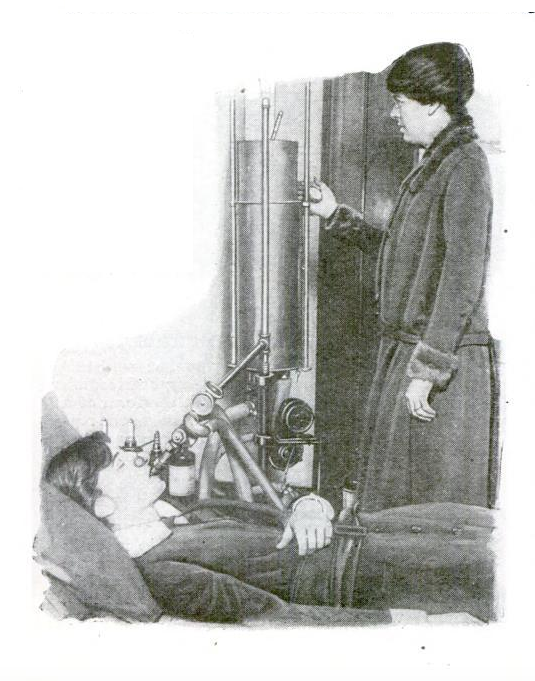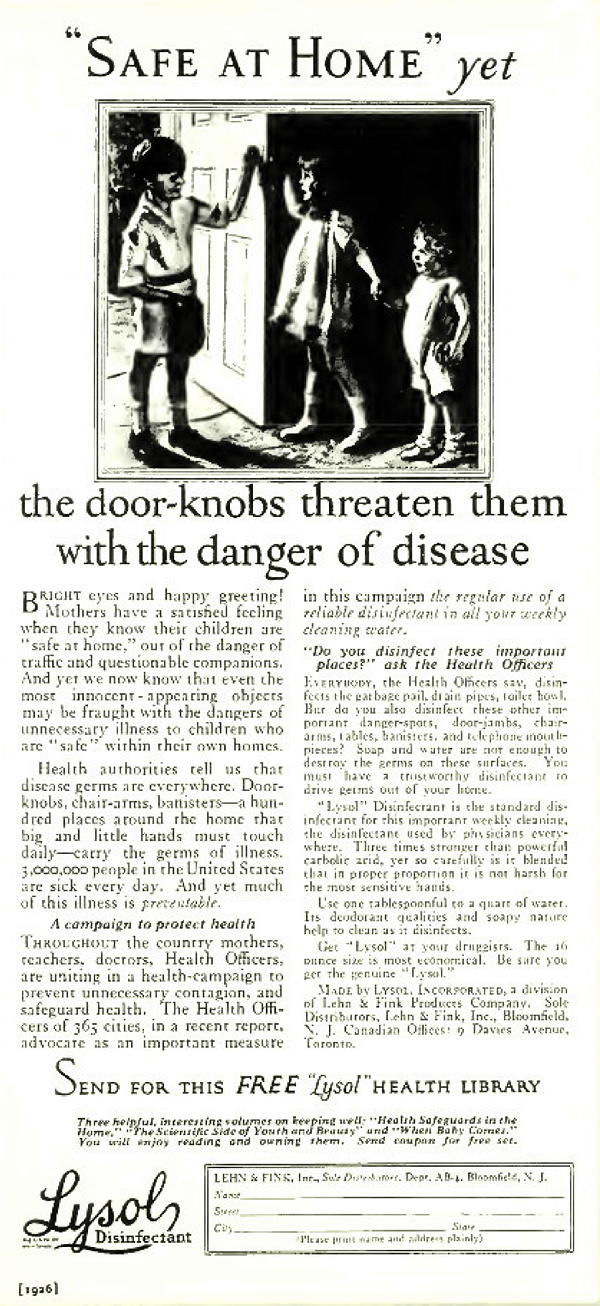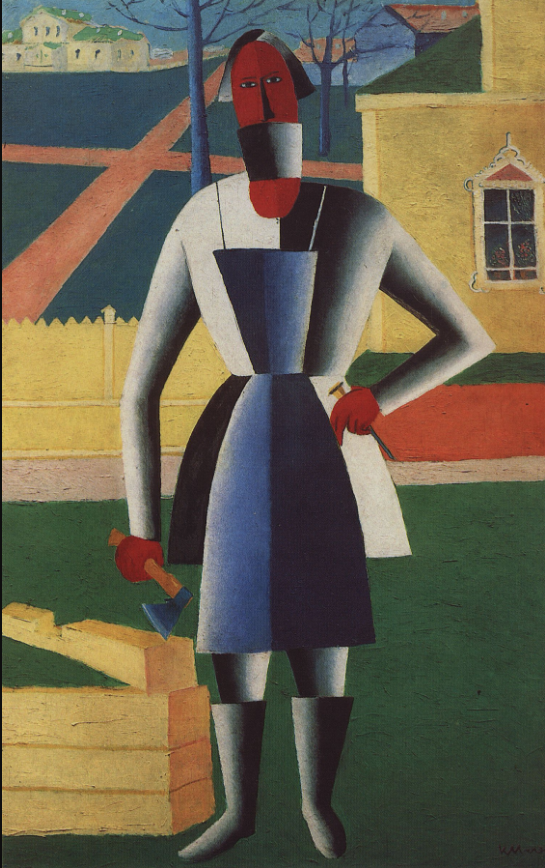1920s
Mystery Gadget 91
What's going on here?The answer is at the source.
Or after the jump.

More in extended >>
Posted By: Paul - Fri Jan 08, 2021 -
Comments (3)
Category: Technology, 1920s
The Door-Knobs Threaten Them
Another example of the early 20th-century advertising industry trying to terrify customers into buying their product.Although they were right that door-knobs can transmit disease.

Ladies Home Journal - 1926
Posted By: Alex - Sat Dec 05, 2020 -
Comments (0)
Category: Advertising, 1920s, Disease
The feather paintings of Ida Jarvis
Ida Helen Jarvis came up with the idea of making pictures out of feathers. She would travel around the world, visiting zoos and aviaries to add to her feather collection. Then she would arrange the feathers to form pictures of landscapes, gluing or stitching the feathers onto a cardboard mat.She was so taken with this idea that she decided to patent it (Patent No. 1,395,575, 1921). Included in her patent was the idea of using down to represent foam in a stream of water.
Her feather paintings must have been quite colorful. But unfortunately the only image of one I can find is the black-and-white drawing included with her patent.

Posted By: Alex - Sun Nov 22, 2020 -
Comments (3)
Category: Art, Inventions, Patents, 1920s
Chlorine gas cures colds
During the 1920s, chlorine gas (the same stuff used as a chemical weapon in World War I) briefly became popular as a cure for the common cold.
The Rushville Daily Republican - Mar 26, 1926
Jennifer Ackerman explains what was going on in her book Ah-Choo! The Uncommon Life of Your Common Cold:
Chlorine was thought to act as a kind of thorn-in-the-flesh therapy. Vedder (dubbed "the chemical warrior" by Time magazine) proposed that "the irritant action of chlorine stimulates the flow of secretion and cleanses the mucous surfaces," resulting in "productive coughing and blowing of the nose." Through its oxidizing action, the gas was also thought to rid the body of toxins and fuel the activity of white blood cells useful in the attack against offending microbes.
Practically overnight, chlorine therapy became a popular treatment for victims of colds, bronchitis, and whooping cough... For the general public, there was Chlorine Respirine, 50 treatments for $0.50 in a handy collapsible tube, each dose purported to "knock a cold in three hours."
Controlled experiments eventually debunked the idea that chlorine gas had any curative value. Though I'm not sure how to explain why people exposed to chlorine didn't seem to catch colds as often. Perhaps it was just mistaken, anecdotal evidence. Or perhaps the chlorine gas was sterilizing surfaces, helping to prevent the transmission of germs.
Posted By: Alex - Fri Nov 20, 2020 -
Comments (1)
Category: Health, Patent Medicines, Nostrums and Snake Oil, Cures for the common cold, 1920s
Germs pick out the weak ones
The theme of this 1920's ad campaign was that if your kid didn't eat Ralston Purina breakfast cereal, then he/she was going to die.
Fitchburg Sentinel - Jan 3, 1928

Pittsburgh Press - Nov 1, 1927
Posted By: Alex - Thu Nov 19, 2020 -
Comments (2)
Category: Health, Advertising, Cereal, 1920s
Martha Graham’s “Heretic”
Early visual representation of social-media shaming. The two clips are different sections of the whole.The Wikipedia entry.
Posted By: Paul - Mon Nov 16, 2020 -
Comments (0)
Category: Religion, 1920s, Dance
Doctor needs money
An unusual list of what a country doctor in 1924 was willing to accept as payment. I wonder if my doctor would accept some goose feathers and soft-shell turtles as a co-pay?
St. Louis Post-Dispatch - Mar 13, 1924
I expect a prompt settlement of all accounts due me. If not possible to settle in cash, any of the following named articles will be acceptable, viz.:
Cotton seed, chickens, ducks, geese, turkeys, billygoats, live catfish over 1 lb. each, bulldogs, registered bird dogs, skunk hides (dry), deer hides, shotguns, cedar posts, watches, gold teeth, diamonds, cream checks, pine trees (2 ft. in diameter, 30 ft. long), automobiles, new or secondhand; peanuts, black-eyed peas, Liberty Bonds, land notes, bacon, lard, country hams, clean goose feathers, soft-shell turtles over 5 lbs. each. Anything that can be sold for cash legally.
I need the money.
I have no idea what "cream checks" are. Google doesn't provide an answer.
Posted By: Alex - Tue Oct 27, 2020 -
Comments (4)
Category: Medicine, Money, 1920s
Artwork Khrushchev Probably Would Not Have Liked 29

"Carpenter," 1927, Kazimir Malevich.
The artist's Wikipedia page.
His complete works here.
Posted By: Paul - Sun Oct 18, 2020 -
Comments (2)
Category: Art, Avant Garde, 1920s, Russia
Carl Bohland’s Auto Wash Bowl
Carl Bohland patented the auto wash bowl in 1921. His idea was that cars would drive into a large, concrete bowl filled with water. After a couple of times around the bowl, the cars would be clean. Or, at least, cleaner.

Bohland managed to open a few auto wash bowls. The problem, however, was that his technique only really cleaned the underside of the cars. This was useful back in the days when many roads were still unpaved and their undersides constantly got filthy. But as road conditions improved, the auto wash bowl became less useful. By the 1930s, the last one had closed.
More info: vintag.es
Posted By: Alex - Sun Oct 11, 2020 -
Comments (5)
Category: Inventions, Patents, 1920s, Cars
Artwork Khrushchev Probably Would Not Have Liked 28

Tatiana Glebova, 1927.
In "Prision," of which there is a preparatory drawing, the painter depicts a world of multiple orientations through diverse interconnected viewpoints, and shows various heads with their musculature visible as if to reveal to us their interminable growth process. Glebova devoutly believed Filonov’s theories on the “universal flowering” and, like him, held that painting should reflect a growth process of the world similar to that of plants, according to which it was permanently active as an independent being.
Source of text.
Posted By: Paul - Thu Aug 27, 2020 -
Comments (0)
Category: Art, Avant Garde, Body Modifications, 1920s, Russia

| Who We Are |
|---|
| Alex Boese Alex is the creator and curator of the Museum of Hoaxes. He's also the author of various weird, non-fiction, science-themed books such as Elephants on Acid and Psychedelic Apes. Paul Di Filippo Paul has been paid to put weird ideas into fictional form for over thirty years, in his career as a noted science fiction writer. He has recently begun blogging on many curious topics with three fellow writers at The Inferior 4+1. Contact Us |




